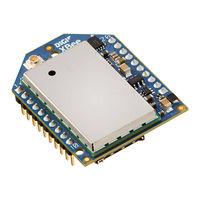Digi XBee Cellular 3G Global Manuals
Manuals and User Guides for Digi XBee Cellular 3G Global. We have 1 Digi XBee Cellular 3G Global manual available for free PDF download: User Manual
Digi XBee Cellular 3G Global User Manual (244 pages)
Embedded Modem
Table of Contents
-
-
-
Examples32
-
-
-
-
Hardware
80 -
-
Modes
102-
Command Mode105
-
Micropython Mode107
-
Sleep Modes
110-
Normal Mode110
-
Pin Sleep Mode110
-
Airplane Mode110
-
The Sleep Timer110
-
-
Serial Interface113
-
Serial Data113
-
UART Data Flow113
-
Serial Buffers114
-
CTS Flow Control114
-
RTS Flow Control114
-
-
SPI Operation
115-
Data Format119
-
File System
120-
-
Paths121
-
Secure Files121
-
XCTU Interface122
-
Encrypt Files122
-
-
SMS Behaviors
123-
SMS Encoding123
-
-
Socket Behavior
125-
Socket Timeouts125
-
-
Examples130
-
-
-
Close the Socket139
-
-
-
API Mode and TLS146
-
Key Formats146
-
Cipher Suites146
-
AT Commands
149-
Special Commands150
-
Force Reset)150
-
SD (Shutdown)151
-
WR (Write)151
-
-
S# (ICCID)152
-
IM (Imei)152
-
MN (Operator)152
-
Pn (Sim Pin)154
-
Pk (Sim Puk)154
-
Network Commands156
-
-
BD (Baud Rate)163
-
NB (Parity)163
-
SB (Stop Bits)164
-
AP (API Enable)165
-
-
-
D0 (Dio0/Ad0)166
-
D1 (Dio1/Ad1)166
-
D2 (Dio2/Ad2)167
-
D3 (Dio3/Ad3)167
-
D4 (Dio4)167
-
D6 (Dio6/Rts)168
-
D7 (Dio7/Cts)169
-
-
-
TP (Temperature)174
-
-
Sleep Commands176
-
SM (Sleep Mode)176
-
ST (Wake Time)176
-
-
-
R (Modem Reset)186
-
-
Error Responses187
-
Atfs Pwd187
-
Atfs Info188
-
-
System Commands192
-
Socket Commands193
-
Socket Info)193
-
-
-
API Frames
200 -
Troubleshooting
232 -
-
FCC Notices239
-
-
2.1 General240
-
2.7 Antennas240
-
-
Antennas241
-
Europe (CE)242
-
ACMA (Australia)244
Advertisement
Advertisement
